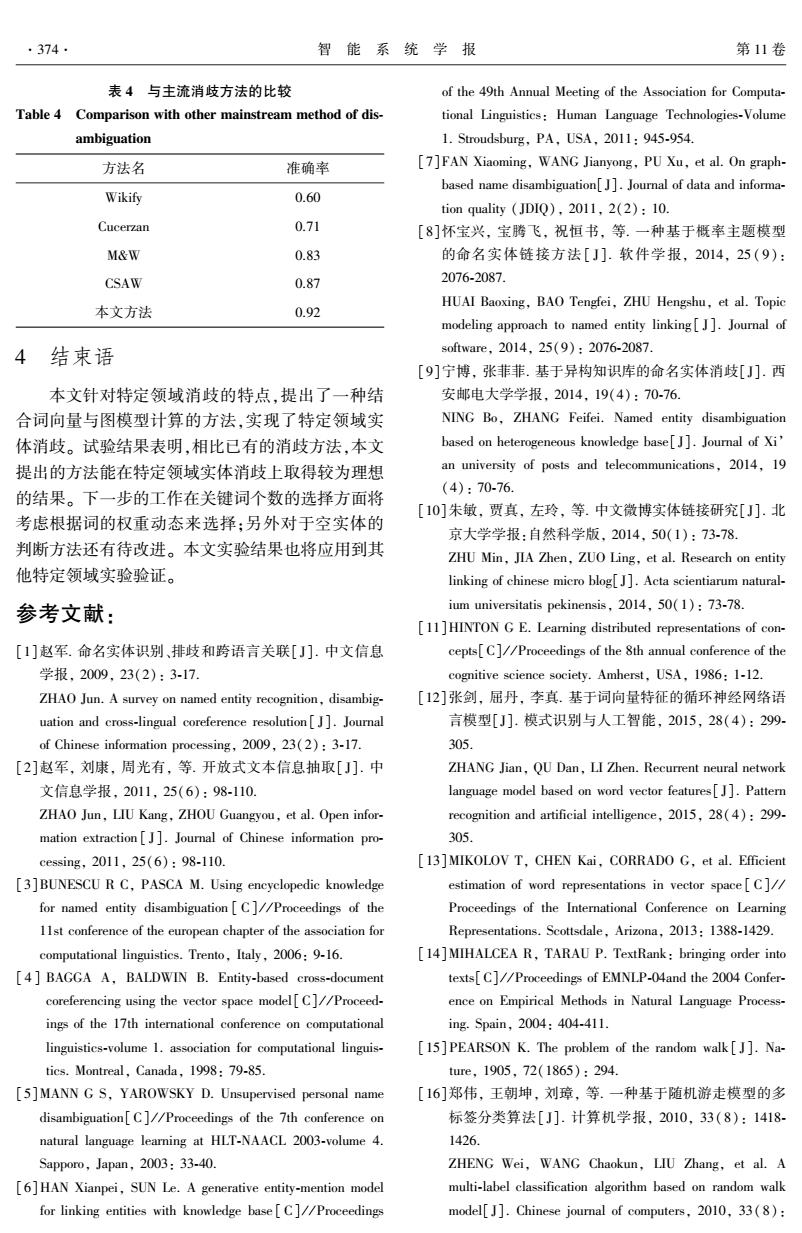正在加载图片...

.374. 智能系统学报 第11卷 表4与主流消歧方法的比较 of the 49th Annual Meeting of the Association for Computa- Table 4 Comparison with other mainstream method of dis- tional Linguistics:Human Language Technologies-Volume ambiguation 1.Stroudsburg,PA,USA,2011:945-954. 方法名 准确率 [7]FAN Xiaoming,WANG Jianyong,PU Xu,et al.On graph- based name disambiguation[].Journal of data and informa- Wikify 0.60 tion quality (JDIQ),2011,2(2):10. Cucerzan 0.71 [8]怀宝兴,宝腾飞,祝恒书,等。一种基于概率主题模型 M&W 0.83 的命名实体链接方法[J].软件学报,2014,25(9): CSAW 0.87 2076-2087. HUAI Baoxing,BAO Tengfei,ZHU Hengshu,et al.Topic 本文方法 0.92 modeling approach to named entity linking[].Journal of 4 结束语 software,2014,25(9):2076-2087. [9]宁博,张菲菲.基于异构知识库的命名实体消歧[J刀].西 本文针对特定领域消歧的特点,提出了一种结 安邮电大学学报,2014,19(4):70-76. 合词向量与图模型计算的方法,实现了特定领域实 NING Bo,ZHANG Feifei.Named entity disambiguation 体消歧。试验结果表明,相比已有的消歧方法,本文 based on heterogeneous knowledge base[J].Journal of Xi' 提出的方法能在特定领域实体消歧上取得较为理想 an university of posts and telecommunications,2014,19 (4):70-76. 的结果。下一步的工作在关键词个数的选择方面将 [10]朱敏,贾真,左玲,等.中文微博实体链接研究[J].北 考虑根据词的权重动态来选择:另外对于空实体的 京大学学报:自然科学版,2014,50(1):73-78. 判断方法还有待改进。本文实验结果也将应用到其 ZHU Min,JIA Zhen,ZUO Ling,et al.Research on entity 他特定领域实验验证。 linking of chinese micro blog[J].Acta scientiarum natural- 参考文献 ium universitatis pekinensis,2014,50(1):73-78. [11]HINTON G E.Learning distributed representations of con- []赵军.命名实体识别、排歧和跨语言关联[J].中文信息 cepts[C]//Proceedings of the 8th annual conference of the 学报,2009,23(2):3-17. cognitive science society.Amherst,USA,1986:1-12. ZHAO Jun.A survey on named entity recognition,disambig- [12]张剑,屈丹,李真.基于词向量特征的循环神经网络语 uation and cross-lingual coreference resolution[J].Journal 言模型[J].模式识别与人工智能,2015,28(4):299- of Chinese information processing,2009,23(2):3-17. 305. [2]赵军,刘康,周光有,等.开放式文本信息抽取[J].中 ZHANG Jian,QU Dan,LI Zhen.Recurrent neural network 文信息学报,2011,25(6):98-110. language model based on word vector features[J].Pattern ZHAO Jun,LIU Kang,ZHOU Guangyou,et al.Open infor- recognition and artificial intelligence,2015,28(4):299- mation extraction[J].Journal of Chinese information pro- 305. cessing,2011,25(6):98-110. [13]MIKOLOV T,CHEN Kai,CORRADO G,et al.Efficient [3]BUNESCU R C,PASCA M.Using encyelopedic knowledge estimation of word representations in vector space[C]// for named entity disambiguation[C]//Proceedings of the Proceedings of the International Conference on Learning 11st conference of the european chapter of the association for Representations.Scottsdale,Arizona,2013:1388-1429. computational linguistics.Trento,Italy,2006:9-16. [14]MIHALCEA R,TARAU P.TextRank:bringing order into [4]BAGGA A,BALDWIN B.Entity-based cross-document texts[C]//Proceedings of EMNLP-04and the 2004 Confer- coreferencing using the vector space model[C]//Proceed- ence on Empirical Methods in Natural Language Process- ings of the 17th international conference on computational ing.Spain,2004:404-411. linguistics-volume 1.association for computational linguis- [15]PEARSON K.The problem of the random walk J].Na- tics.Montreal,Canada,1998:79-85. ture,1905,72(1865):294. [5]MANN G S,YAROWSKY D.Unsupervised personal name [16]郑伟,王朝坤,刘璋,等.一种基于随机游走模型的多 disambiguation[C]//Proceedings of the 7th conference on 标签分类算法[J].计算机学报,2010,33(8):1418- natural language learning at HLT-NAACL 2003-volume 4. 1426. Sapporo,Japan,2003:33-40. ZHENG Wei,WANG Chaokun,LIU Zhang,et al.A [6]HAN Xianpei,SUN Le.A generative entity-mention model multi-label classification algorithm based on random walk for linking entities with knowledge base [C]//Proceedings model[J].Chinese journal of computers,2010,33(8):表 4 与主流消歧方法的比较 Table 4 Comparison with other mainstream method of dis⁃ ambiguation 方法名 准确率 Wikify 0.60 Cucerzan 0.71 M&W 0.83 CSAW 0.87 本文方法 0.92 4 结束语 本文针对特定领域消歧的特点,提出了一种结 合词向量与图模型计算的方法,实现了特定领域实 体消歧。 试验结果表明,相比已有的消歧方法,本文 提出的方法能在特定领域实体消歧上取得较为理想 的结果。 下一步的工作在关键词个数的选择方面将 考虑根据词的权重动态来选择;另外对于空实体的 判断方法还有待改进。 本文实验结果也将应用到其 他特定领域实验验证。 参考文献: [1]赵军. 命名实体识别、排歧和跨语言关联[ J]. 中文信息 学报, 2009, 23(2): 3⁃17. ZHAO Jun. A survey on named entity recognition, disambig⁃ uation and cross⁃lingual coreference resolution[ J]. Journal of Chinese information processing, 2009, 23(2): 3⁃17. [2]赵军, 刘康, 周光有, 等. 开放式文本信息抽取[ J]. 中 文信息学报, 2011, 25(6): 98⁃110. ZHAO Jun, LIU Kang, ZHOU Guangyou, et al. Open infor⁃ mation extraction [ J]. Journal of Chinese information pro⁃ cessing, 2011, 25(6): 98⁃110. [3]BUNESCU R C, PASCA M. Using encyclopedic knowledge for named entity disambiguation [ C] / / Proceedings of the 11st conference of the european chapter of the association for computational linguistics. Trento, Italy, 2006: 9⁃16. [ 4 ] BAGGA A, BALDWIN B. Entity⁃based cross⁃document coreferencing using the vector space model[C] / / Proceed⁃ ings of the 17th international conference on computational linguistics⁃volume 1. association for computational linguis⁃ tics. Montreal, Canada, 1998: 79⁃85. [5]MANN G S, YAROWSKY D. Unsupervised personal name disambiguation[C] / / Proceedings of the 7th conference on natural language learning at HLT⁃NAACL 2003⁃volume 4. Sapporo, Japan, 2003: 33⁃40. [6]HAN Xianpei, SUN Le. A generative entity⁃mention model for linking entities with knowledge base [ C] / / Proceedings of the 49th Annual Meeting of the Association for Computa⁃ tional Linguistics: Human Language Technologies⁃Volume 1. Stroudsburg, PA, USA, 2011: 945⁃954. [7]FAN Xiaoming, WANG Jianyong, PU Xu, et al. On graph⁃ based name disambiguation[J]. Journal of data and informa⁃ tion quality (JDIQ), 2011, 2(2): 10. [8]怀宝兴, 宝腾飞, 祝恒书, 等. 一种基于概率主题模型 的命名实体链接方法[ J]. 软件学报, 2014, 25 ( 9): 2076⁃2087. HUAI Baoxing, BAO Tengfei, ZHU Hengshu, et al. Topic modeling approach to named entity linking [ J]. Journal of software, 2014, 25(9): 2076⁃2087. [9]宁博, 张菲菲. 基于异构知识库的命名实体消歧[ J]. 西 安邮电大学学报, 2014, 19(4): 70⁃76. NING Bo, ZHANG Feifei. Named entity disambiguation based on heterogeneous knowledge base[ J]. Journal of Xi’ an university of posts and telecommunications, 2014, 19 (4): 70⁃76. [10]朱敏, 贾真, 左玲, 等. 中文微博实体链接研究[ J]. 北 京大学学报:自然科学版, 2014, 50(1): 73⁃78. ZHU Min, JIA Zhen, ZUO Ling, et al. Research on entity linking of chinese micro blog[J]. Acta scientiarum natural⁃ ium universitatis pekinensis, 2014, 50(1): 73⁃78. [11]HINTON G E. Learning distributed representations of con⁃ cepts[C] / / Proceedings of the 8th annual conference of the cognitive science society. Amherst, USA, 1986: 1⁃12. [12]张剑, 屈丹, 李真. 基于词向量特征的循环神经网络语 言模型[J]. 模式识别与人工智能, 2015, 28(4): 299⁃ 305. ZHANG Jian, QU Dan, LI Zhen. Recurrent neural network language model based on word vector features[ J]. Pattern recognition and artificial intelligence, 2015, 28(4): 299⁃ 305. [13]MIKOLOV T, CHEN Kai, CORRADO G, et al. Efficient estimation of word representations in vector space [ C] / / Proceedings of the International Conference on Learning Representations. Scottsdale, Arizona, 2013: 1388⁃1429. [14]MIHALCEA R, TARAU P. TextRank: bringing order into texts[C] / / Proceedings of EMNLP⁃04and the 2004 Confer⁃ ence on Empirical Methods in Natural Language Process⁃ ing. Spain, 2004: 404⁃411. [15] PEARSON K. The problem of the random walk[ J]. Na⁃ ture, 1905, 72(1865): 294. [16]郑伟, 王朝坤, 刘璋, 等. 一种基于随机游走模型的多 标签分类算法[ J]. 计算机学报, 2010, 33( 8): 1418⁃ 1426. ZHENG Wei, WANG Chaokun, LIU Zhang, et al. A multi⁃label classification algorithm based on random walk model[ J]. Chinese journal of computers, 2010, 33(8): ·374· 智 能 系 统 学 报 第 11 卷